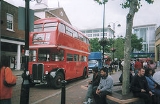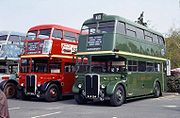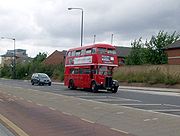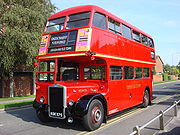
AEC Regent III RT
Encyclopedia

AEC Regent III
The AEC Regent III was a type of double-decker bus chassis manufactured by AEC.It was mainly built for operation outside London and overseas. It could be fitted with AEC's 9.6-litre diesel engine , 'Wilson' preselective epicyclic gearbox The AEC Regent III (also known as Regent 3 or Regent Mark...
. It was a double-decker bus
Double-decker bus
A double-decker bus is a bus that has two storeys or 'decks'. Global usage of this type of bus is more common in outer touring than in its intra-urban transportion role. Double-decker buses are also commonly found in certain parts of Europe, Asia, and former British colonies and protectorates...
produced jointly between AEC and London Transport
London Passenger Transport Board
The London Passenger Transport Board was the organisation responsible for public transport in London, UK, and its environs from 1933 to 1948...
. It was the standard red London bus during the 1950s.
Prototype
The prototype (London Transport RT 1) was built in 1938 with AEC's 8.8-litre engine (a stopgap measure until the new 9.6-litre was available) and air-operated pre-selective gearbox. Finding a satisfactory British substitute for the German air compressor, bought from Bosch, was to cause problems for AEC, once war broke out. A prototype chassis was placed into service, disguised as an old vehicle. It carried a secondhand open-staircase body previously carried on Leyland Titan (fleet number TD 111), dating from 1931. Thus bodied, RT 1 entered service in July 1938 as ST 1140, even though it was nothing like a standard ST vehicle. It continued in service until December 1938.While the chassis was on trial, a new body was constructed at London Transport's Chiswick works. Its four-bay body resembled that of the conventional Roe body exhibited at the 1937 Commercial Motor Show, though the overall impression of modern design and the features included marked a big step forward. This body replaced the old one on RT 1 and the bus re-entered service in 1939.
Pre-war production vehicles
London Transport ordered 338 (later cut to 150) chassis which were in production when the warWorld War II
World War II, or the Second World War , was a global conflict lasting from 1939 to 1945, involving most of the world's nations—including all of the great powers—eventually forming two opposing military alliances: the Allies and the Axis...
broke out in September 1939. The last of the batch, RT 151, did not reach London Transport until January 1942. The only other RT-type chassis constructed before the end of the war was destined for Glasgow
Glasgow
Glasgow is the largest city in Scotland and third most populous in the United Kingdom. The city is situated on the River Clyde in the country's west central lowlands...
, originally intended to be an exhibit at the 1939 Commercial Motor show, but cancelled due to the outbreak of war. It differed from the pre-war London examples in having a body built by Weymann, though the cab area was very similar to the London vehicles.
Post-war production vehicles



- The ultimate (narrow) destination blind was now located just above the driver with the via blind (wide) between the ultimate and the top deck windows.
- The front route number remained above the top deck windows (known by some as the lighthouse box...as well as the more widely used roofbox) although the rear one was removed and the route number joined the 'via' points in the main display.
- The bodywork was constructed by contractors rather than by London Transport.
- The lower edge of the cab window forward of the driver's door and the lower edge of the driver's windscreen were horizontal, whereas on pre-war examples they curved downwards towards the corner of the cab. Also, the lower offside bodyside, behind the rear wheel, did not curve is, as that before the rear wheel.
- The number of ventilation slats below the windscreen was reduced from 6 to 4.
In total, London Transport received 4,674 post-war RT-class buses between 1947 and 1954, with a small number of similar buses being sold to operators outside London (see below).
However, the London "RT" family of vehicles could be considered to have numbered 6,956 in total, consisting of 4,825 RTs; 1,631 RTLs and 500 RTWs. The latter two types had a variant of the Leyland Titan chassis and, in addition, the RTW's were 8 feet wide (as opposed to 7 feet 6 inches). The whole family were never all in operation at the same time.
The very last RT (RT624, now preserved by Ensignbus
Ensignbus
Ensignbus is a Purfleet-based bus and coach dealer, open top bus tour operator and bus service operator. Ensignbus has amassed 20 ex-London vehicles of various ages and conditions in a ....
) operated on route 62 from Barking
Barking
Barking is a suburban town in the London Borough of Barking and Dagenham, in East London, England. A retail and commercial centre situated in the west of the borough, it lies east of Charing Cross. Barking was in the historic county of Essex until it was absorbed by Greater London. The area is...
Garage on 7 April 1979.
Like the pre-war Glasgow vehicle, not all post-war production went to London Transport. Between 1946 and 1951, 101 chassis were delivered to ten other operators. Of these, only forty had RT-style bodies, thirty nine, by Park Royal, for St Helens Corporation and one, by Metro-Cammell, for Coventry Corporation. The external link below has more information.
Knight Bus
Three RT buses (RT2240, RT3882 and RT4497) were rebuilt into a triple-decker vehicle (known as the Knight Bus) for a Harry PotterHarry Potter
Harry Potter is a series of seven fantasy novels written by the British author J. K. Rowling. The books chronicle the adventures of the adolescent wizard Harry Potter and his best friends Ron Weasley and Hermione Granger, all of whom are students at Hogwarts School of Witchcraft and Wizardry...
film: Harry Potter and the Prisoner of Azkaban
Harry Potter and the Prisoner of Azkaban (film)
Harry Potter and the Prisoner of Azkaban is a 2004 fantasy film directed by Alfonso Cuarón and based on the novel of the same name by J. K. Rowling. It is the third instalment in the Harry Potter film series, written by Steve Kloves and produced by Chris Columbus, David Heyman and Mark Radcliffe...
.
See also
- UnitransUnitransUnitrans is the name for the transit system which operates in Davis, California. It takes its name from an abbreviation of the words "University Transport". Excepting several managerial and maintenance positions, Unitrans is managed and operated entirely by students of the University of...
- Unitrans RT742Unitrans RT742Unitrans RT742 is an ex-London Transport double decker bus operated in regular service by Unitrans in Davis, California. RT742 has been restored to its original appearance and is the only double decker bus in the Unitrans fleet to retain its original roofbox...
- Unitrans RT1235Unitrans RT1235Unitrans RT1235 is an ex-London Transport double decker bus operated in regular service by Unitrans in Davis, California. In the early 1990s, RT1235's original British-made AEC diesel engine and Wilson pre-select manual transmission was replaced with an American-made Cummins diesel engine and an...
- Unitrans RT1523Unitrans RT1523Unitrans RT1523 was an ex-London Transport double decker bus owned by Unitrans in Davis, California. Having been sold, it is no longer part of the Unitrans fleet.-Technical specifications:Manufacturer : Associated Equipment Company...
- Unitrans RT2819Unitrans RT2819Unitrans RT2819 is an ex-London Transport double decker bus operated in regular service by Unitrans in Davis, California. In the early 1990s, RT2819's original British-made AEC diesel engine and Wilson pre-select manual transmission was replaced with an American-made Cummins diesel engine and an...
- Unitrans RT3123Unitrans RT3123Unitrans RT3123 is an ex-London Transport double decker bus operated in regular service by Unitrans in Davis, California. In the early 1990s, RT3123's original British-made AEC diesel engine and Wilson pre-select manual transmission was replaced with an American-made Cummins diesel engine and an...
- Unitrans RT3572Unitrans RT3572Unitrans RT3572 was an ex-London Transport double decker bus operated in regular service by Unitrans in Davis, California. Having been sold in 1977, it is no longer part of the Unitrans fleet.-Technical specifications:...
- Unitrans RT3889Unitrans RT3889Unitrans RT3889 is an ex-London Transport double decker bus that was once operated in regular service by Unitrans in Davis, California. Having been sold, it is no longer part of the Unitrans fleet.-Technical specifications:...
- Unitrans RT4735Unitrans RT4735Unitrans RT4735 is a former London Transport double decker bus operated in regular service by Unitrans in Davis, California. In the early 1990s, RT1235's original British-made AEC diesel engine and Wilson pre-select manual transmission were replaced with an American-made Cummins diesel engine and...
- Unitrans RT742

